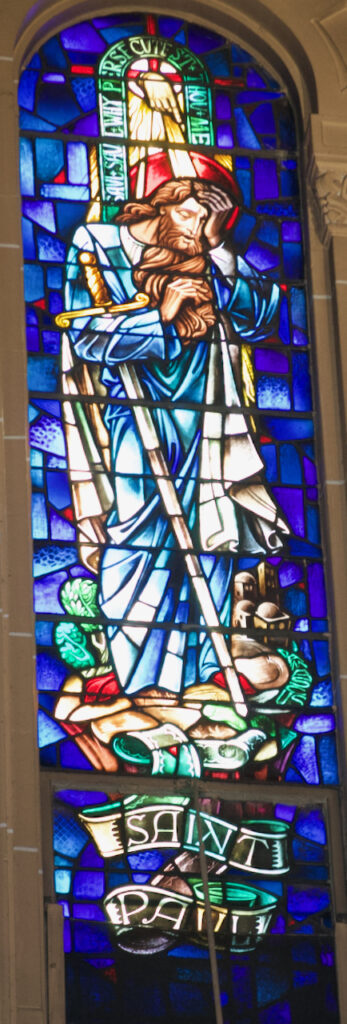January 25 is the Feast of the Conversion of St. Paul. The St. Paul window is the first on the left in the sanctuary of the church. It depicts the moment of Paul’s conversion and also his ministry as an Apostle of Christ. He was likely born about the same time as Jesus or a little after, and was named Saul. He lived in Syria, became a tentmaker, and as a Pharisee he zealously observed Jewish law and practices.
After Jesus’ Ascension into heaven and the coming of the Holy Spirit upon the Apostles at Pentecost, the emerging Christian faith was spread by the preaching of the Apostles. Saul vehemently opposed this new teaching. He was present at, and complicit in, the stoning of Stephen, the first Christian martyr. (Acts 7:58) Saul became an avid persecutor of the early Christians, but he had a radical conversion as he was travelling to Damascus intending to imprison disciples of Jesus there.

On the road “..a light from the sky suddenly flashed around him. He fell to the ground and heard a voice saying to him, ‘Saul, Saul, why are you persecuting me?’ He said, ‘Who are you, sir?’ The reply came, ‘I am Jesus, whom you are persecuting.’(Acts 9:3-5)
The town of Damascus is on the right in the window with letters spelling the town’s name paving the road. The light from heaven is shining upon Saul. A red cross is seen in the light with a hand extending from it, pointing at Saul. The words of Jesus that Saul heard form an arch from which the light and hand emerge.
When Saul arose he could not see. In the window, Saul’s hand shielding his eye suggests this temporary blindness. Those who accompanied him also heard the voice, and they led him to Damascus where he waited. God called a disciple, Ananias, to pray with Saul that he might regain his sight. Through this experience Saul became an ardent disciple of Jesus and was called by Him to witness and preach the Gospel to Jews, Gentiles, ordinary people, and royalty throughout Asia Minor, Greece, and eventually in Rome, where he was finally martyred. The hand pointing at him symbolizes this call and the blue color of his garment suggests the presence of God throughout his ministry. His red halo suggests the martyr’s death that he would die. Saul was also known as Paul. (Acts 13:9)
Much of the Acts of the Apostles describes Paul’s travels and ministry and the Christian communities that he founded. It also describes the persecution he often suffered for his faith and preaching. Letters that he wrote to these churches comprise much of the New Testament.
In the window, a very long sword resembling a cross rests in Paul’s arm. In his writing Paul encouraged Christians to take up “…the sword of the spirit, which is the word of God.” (Eph 6:17.) Paul’s faithful preaching was truly God’s word. The book of Hebrews describes God’s word as, “…living and effective, sharper than any two-edged sword, penetrating even between soul and spirit, joints and marrow, and able to discern reflections and thoughts of the heart.” (Heb 4:12)
As we reflect on this window and the radical conversion of Paul, who then spread the Gospel throughout parts of today’s Middle East and into Europe, let us ask God to also grant us an ongoing conversion of heart that we too might spread God’s Word to those we meet.